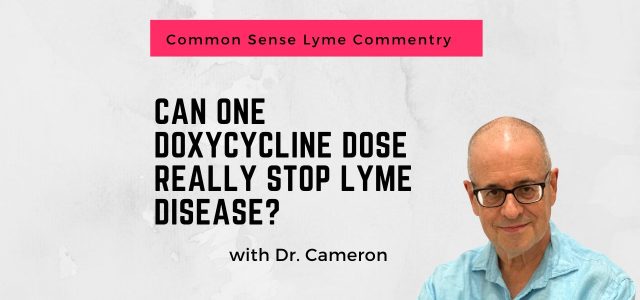Call for your appointment today 914-666-4665 | Mt. Kisco, New York

When a patient walks into my office after a tick bite, they often ask: “Isn’t one dose of doxycycline enough to prevent Lyme disease?”
That belief traces back to a 2001 study that has, unfortunately, shaped Lyme disease treatment guidelines. But what most people don’t realize is that the study only found that the single dose prevented the classic Bull’s-eye rash, not the full spectrum of Lyme disease symptoms. Over time, I’ve seen how treating with only a single dose can leave patients vulnerable to chronic illness.
So today, let’s unpack the science and the clinical reality of this common misperception—in the form of a conversation.
💬 Clinical Dialogue on the Single-Dose Doxycycline for a Tick Bite
Cameron: Let’s talk about the single-dose doxycycline recommendation.
Colleague: The 200 mg dose for tick bite prophylaxis?
Cameron: That’s the one. It’s been included in the IDSA (Infectious Disease Society of America) guidelines since the early 2000’s.
Colleague: Right. The findings were based on the Nadelman study with results indicating an 87% efficacy in preventing erythema migrans rashes if given within 72 hours.
Cameron: But that’s just it. The endpoint was a rash. Not late neurologic Lyme. Not Lyme arthritis.
Colleague: True. And they excluded children, pregnant women, and people who weren’t sure about the timing of the tick bite.
Cameron: Not to mention, no long-term follow-up to monitor for late-onset symptoms.
Colleague: So it’s a narrow window of benefit—for a narrow group of patients.
Cameron: And yet it’s been applied broadly. I’ve seen patients who were told they were “protected,” only to return months later with joint pain, brain fog, or cardiac issues.
Colleague: But isn’t one dose better than nothing?
Cameron: Not if it gives a false sense of security. Or delays treatment.
Colleague: How often do you see that happen?
Cameron: Too often. In my practice, I treat every engorged tick bite. If someone gets sick in the following weeks—even without a rash—I treat empirically.
Colleague: That’s more aggressive than the guidelines.
Cameron: It’s more realistic. We’re not treating mice in a lab. We’re treating people who want to stay well.
Colleague: Have you seen anyone harmed by the one-dose approach?
Cameron: Yes. I had one patient who developed Bell’s palsy and arthritis weeks after the tick bite. She’d been told one dose was enough.
Colleague: But what about antibiotic overuse?
Cameron: That concern matters. But the cost of under-treatment—of letting someone slip into chronic illness—is far greater.
Colleague: So, what’s the alternative?
Cameron: A full 3-week course for anyone with a high-risk bite. And follow-up. Every case deserves more than a one-size-fits-all solution.
🔬 What the Original Nadelman Study Found
The 2001 study by Nadelman et al. showed that a single 200 mg dose of doxycycline could reduce the risk of developing erythema migrans (the bull’s-eye rash) when given within 72 hours of removing an Ixodes scapularis tick.
But it had major limitations:
-
No long-term follow-up to determine if patients developed neurologic or arthritic Lyme disease
-
Exclusion of high-risk groups (children, pregnant women, unclear exposure)
-
No testing for co-infections like Babesia or Anaplasma
-
Narrow endpoint focused on a rash—not systemic disease
🩺 Why Clinical Judgment Still Matters
The reality is:
-
Not every Lyme case presents with a rash
-
Symptoms can develop weeks or months later
-
Some patients are misdiagnosed or told they’re fine based on that one dose
-
Tick-borne co-infections are rising—and not addressed by doxycycline alone
✅ What I Do Instead in My Practice
In my office, I use a different approach—one rooted in experience, not shortcuts:
-
No one-day treatment for tick bites
-
Treat every engorged tick bite with a full 3-week course of antibiotics
-
Treat any illness that appears within 4–6 weeks of a known tick exposure
-
Treat non-classic rashes (not just Bull’s-eye)
-
Treat Bell’s palsy with antibiotics, even if tests are negative
-
Follow up closely to monitor for evolving symptoms and prevent chronic illness
🧭 Final Thoughts
A one-size-fits-all solution might be convenient—but Lyme disease is complex.
If we want to prevent long-term suffering, we need to treat the person, not just the tick.




Dear Dr. Cameron. I live in Ont, Canada. I have Lyme and Morgellons.
I received a positive Lyme from Germany. All tests were negative here. This was fall of 2019.
I had been experiencing vertigo, TMJ inflammation, sparkles in both eyes when in the dark, loss of appetite, severe lethargy, brain fog, severe irritability, swollen rt. knee, painful joints,
Loss of balance, gum disease, teeth pain and misalignment , developed two hammer toes – second toe on both feet, knee joints felt like they would dislocate, stiff legs, weakness in legs and arms, lipomas everywhere, sensation of hairs tickling my face, heat/cold intolerance, and I could go on and on.
I have never had any mental problems. Only on natural thyroid extract for past 34 years. Cancer of thyroid .
Blood tests normal except for CRP which was 35. No antibiotics . I had a zoom meeting with Dr. Stricker in San Francisco. He ordered tests and 6 months of antibiotics. Ont doctor would not order tests ir give more than two weeks antibiotics. I could not travel to the USA because I did not take the experimental shot so could not go over the border.
Help from a Naturopathic Doctor was my next resort.
Today, I am improving, I think. I can wear shoes, I walk with a stick, can go up and down stairs with help, appetite has returned, tmj joint improving, gum disease gone, a little more energy, less irritable, brain fog lifting,
Painful skin ulcers are still occurring . Lipomas seemed to contain filaments, cysts . After years, none ever became infected. Seemed to not have blood supply. Strange for sure.
My question is: what do you know about Morgellons?
Like your articles. Short and to the point. Attention span not great.
Thank you for taking the time to read my story.
Margaret Hibbs
I have patients whose Morgellons is much better with treatment for Lyme disease. I also have patients who have not responded. I am hoping there is more research on this condition soon.
Thank-you for educating people on this topic!
Thanks. It has always been a pleasure to hear from you.
I just removed a deer tick from my ankle this morning. It was engorged and I think it had been there two or three days. I did a telehealth visit and was prescribed 200mg doxycycline. Now, reading your article, I am afraid that I will still develop it. I was skeptical about what 200 mg could do. I was feeling bad—-headache and neck pain and lethargy. Are there any other antibiotics acceptable for treating this prophylactically? Should I see my PCP? I already have arthritis and not sure I could deal with this on top of that. Thank you.
I have my concerns. I advise my patients to discuss the options with their doctor. I understand your concern. It might be difficult to look for Lyme arthritis if arthritis is already an issue.
In the Netherlands the Lyme protocol also refers to one course of antibiotics after a tick bite, when the tick is removed within a short period of time. I suffered from severe Lyme symptoms after such a short course. I would like to ask your permission to translate your very interesting blog about this topic for the magazine of the Lyme patients Organization of the Netherlands. I hope I may hear from you!
I appreciate your efforts Let me know if I can help you.